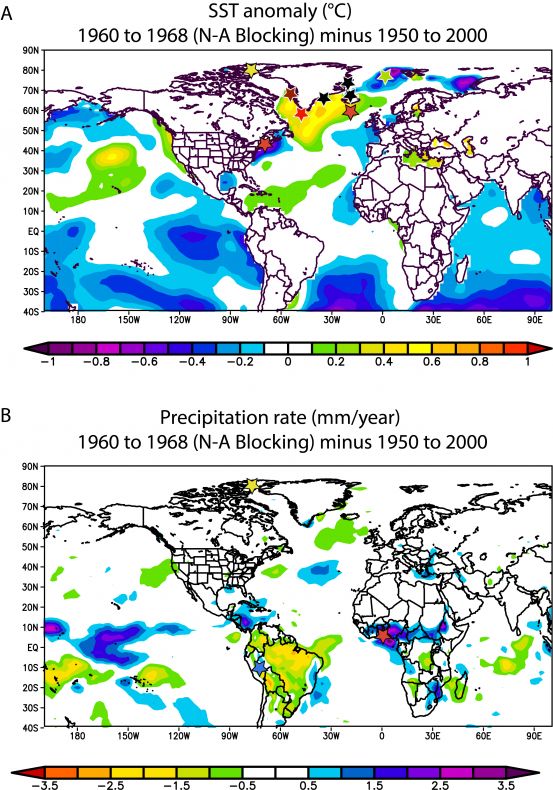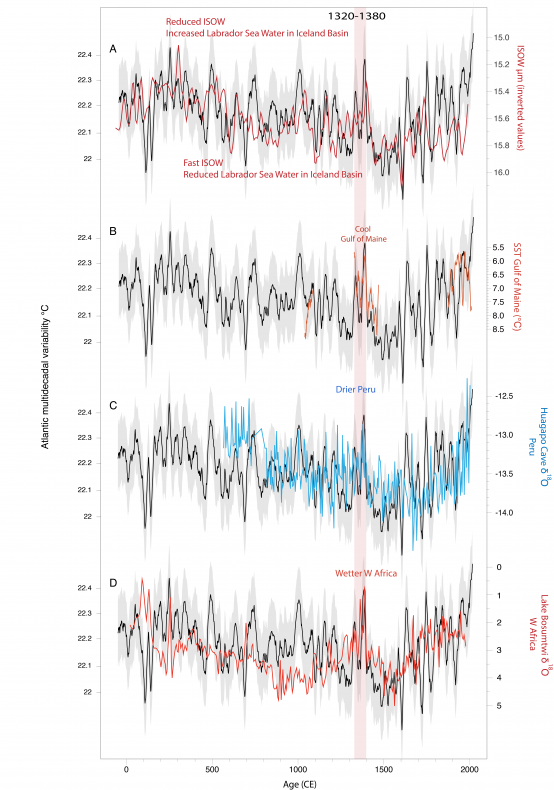The author(s) will give a talk
Little Ice Age triggered by intrusion of Atlantic waters into the Nordic Seas
1 University of Massachusetts-Amherst
2 University of Massachusetts-Amherst
3 Bates College/The University Centre in Svalbard
The Little Ice Age was one of the coldest periods of the last ~10,000 years in the Northern-Hemisphere. Although there is increasing evidence that this cooling was associated with a weakening of the Atlantic Meridional Overturning Circulation (AMOC), the sequence of events that led to a significant reduction in deep convection has yet to be explained. A recent reconstruction of Atlantic multidecadal variability (AMV) reveals that sea surface temperatures (SST) in the North-Atlantic were lowest in the interval from ~1400-1600CE (Lapointe et al. 2020), a period that was preceded by anomalously high SSTs in the late 1300s as revealed by a number of highly resolved paleoceanographic proxies (Figure 1). Here, we show that the reconstructed AMV co-varies with periods of increased Atlantic blocking frequency stretching from Greenland to Western Europe over the past ~200 years, consistent with the instrumental record (Häkkinen et al. 2011). Anomalously high blocking activity occurred between 1960-1968 (Ionita et al. 2016), when SST anomalies were warmer in the Labrador Sea (Figure 2a). We argue that this SST pattern may have prevailed during the late 1300s as revealed by many palaeoceanographic proxies in the subpolar gyre (Figure 1). In addition, cooler SSTs, as indicated in a unique annually resolved bivalve shell record from the Gulf of Maine, is coherent with the notion of Atlantic high latitude blocking in the late 1300s (Figure 3b). This pattern is reminiscent of the AMOC SST fingerprint (Yan et al. 2018) in which warmer (cooler) conditions are observed in the subpolar gyre (Gulf Stream region) (Figure 2a).
On a larger scale, precipitation anomalies reveal drier conditions in S. America and extremely wet conditions in W. Africa during the increased blocking activity of the 1960s (Figure 2b), which is also consistent with drier and extremely wet conditions in the late 14th century seen in paleo records from Peru and Ghana, respectively (Figure 3 c,d). These lines of evidence support our assertion that the late 1300s was a period of enhanced atmospheric blocking in the North-Atlantic. Upon the weakening of the 1960s blocking event, increased sea ice export from Fram Strait triggered the Great Salinity Anomaly (1970s) and the subsequent weakening of the AMOC in ~1976-1985 (Ionita et al. 2016). Taken together, this is strongly suggestive that the late 1300s was a period of strengthening of the AMOC (strong blocking) that was followed by an extreme flushout of arctic sea ice, now termed the ‘great sea ice anomaly’ (Miles et al. 2020), that culminated in the late 14th century. We conclude that the advection of warm Atlantic waters into the Arctic led to the export of sea-ice and weakening of the AMOC in the early 1400s (Figure 3a), setting the stage for the subsequent Little Ice Age.
Alonso-Garcia, M. et al., 2017, Freshening of the Labrador Sea as a trigger for Little Ice Age development. Climate Past 13, 317-331.
Häkkinen, S. et al, 2011, Atmospheric blocking and Atlantic multidecadal ocean variability. Science 334, 655-659.
Ionita, M. et al, 2016, Linkages between atmospheric blocking, sea ice export through Fram Strait and the AMOC. Scientific reports 6, 1-10.
Kanner, L. C. et al, 2013, High-resolution variability of the South American summer monsoon over the last seven millennia. QSR 75, 1-10.
Lapointe, F. et al, 2020, Annually resolved Atlantic sea surface temperature variability over the past 2,900 y. PNAS 117, 27171-27178.
Moffa-Sánchez, P. & Hall, I. R., 2017, North Atlantic variability and its links to European climate over the last 3000 years. Nature communications 8, 1-9.
Moffa-Sánchez, P. et al, 2014, Surface changes in the eastern Labrador Sea around the onset of the Little Ice Age. Paleoceanography 29, 160-175.
Perner, K. et al, 2015, Mid to late Holocene strengthening of the East Greenland Current linked to warm subsurface Atlantic water. QSR 129, 296-307.
Shanahan, T. M. et al, 2009, Atlantic forcing of persistent drought in West Africa. Science 324, 377-380.
Wanamaker Jr, A. D. et al, 2011, Gulf of Maine shells reveal changes in seawater temperature seasonality during the MC and the LIA. PPP 302, 43-51.
Yan, X. et al, 2018, Underestimated AMOC variability and implications for AMV. GRL 45, 4319-4328.

Fig 1.
Selected highly resolved proxies from the Nordic Seas showing the transition from the 14th to the 15th century along with the reconstructed AMV. A) SST from the Voring Plateau, off Norway (Berner et a. 2011); B) Ice rafted debris (IRD) in East Fram Strait (Perner et al. 2015). C) % of planktonic foraminifera (N. Pachyderma) (Moffa-Sanchez et al. 2017) and D) d18O T. quinqueloba (Alonso-Garcia et al. 2017, Moffa-Sanchez et al. 2014) in the Labrador Sea.

Fig 2.
A: SST anomalies during period of increased blocking (1960-1968) compared to 1950-2000. B, same as A, but for precipitation rate (mm/year). Yellow star is the location of Sawtooth Lake (reconstructed AMV), colored stars are selected sites shown in Figures 1 and 3, while black stars are other sites depicting the 14/15th century anomaly not shown here. Blue and red stars in B denote the location of the Huagapo Cave and Bosumtwi Lake, respectively.

Fig 3.
AMOC fingerprint during the transition from the 14th to the 15th century. a) Iceland Scotland Overturning Water (ISOW) sortable silt (Moffa-Sanchez et al. 2017) compared to reconstructed AMV. B, same as A) but for the reconstructed SST in the Gulf of Maine from bivalve shells (Wanamaker et al. 2011) (red). The ISOW record is filtered by a 3 point gaussian filter (A), and the bivalve shell record is smoothed by a 5 year gaussian filter (B). C and D, same as A and B, but AMV compared with Huagapo Cave d18O in Peru (Kanner et al. 2013) (C), and d18O at Lake Bosumtwi (Shahanan et al. 2009) (D).